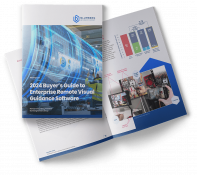Help Lightning Blog
Using Touchless Service Delivery To Remove Friction

Initiative to Improve Customer Experiences
In recent years, companies are improving their Customer Experience (CX) through Digital Transformation (DX). These efforts have centered on using technology to eliminate or reduce time-consuming tasks involved in customer-facing processes. Any process or activity where there are too many touch points can create friction.
The more touches, the more time involved and the more friction.
Field Service and remote support have proven to be fertile grounds for reaping the rewards of DX initiatives. Indeed, there are numerous touchpoints within the service supply chain. Unfortunately, each touchpoint adds time and cost, negatively impacting both service providers and end-customers alike.
DX initiatives supported by enabling technologies like AR, IoT, and AI have led to a new standard of service. Service tasks that took hours to perform can now be performed in less time with less human intervention. As a result, customer expectations have changed. They demand a rapid, always on, always available service experience. But they are willing to be more engaged in the service process than ever before.
These developments all helped set the stage for dealing with the current pandemic.
New Challenges to Field Service Delivery
The new realities of Covid-19 have placed a greater demand on the need for remote or touchless service. We are aware of the need for social distancing and face masks to prevent the spread of the virus. Of course, if someone contracts the virus, the will need to quarantine. Some cohorts, for example, the elderly and those with comorbidity issues, need to self-quarantine.
These issues create new demands for FSOs. On one hand, end-customers still expect high quality, fast, and reliable service. On the other hand, Covid-19 places constraints on service delivery. Service resolution becomes a challenge if the customer does not allow or limits FSEs on their premises.
During the initial days of the pandemic, when the country went into lockdown, many FSOs stopped dispatching technicians entirely. Yet, their customers still required support. New workflows and processes, to support emerging requirements, allowed for touchless service. In parallel, customers adjusted their expectations, taking a more participative and collaborative role in the service experience.
Delivering touchless service, also known as contactless service, is straightforward and easy to implement in some industries. For example, touchless delivery essentially involves leaving the package at the front door. In this case, notifying the customer that the package has been delivered. However, touchless service is more complex when it comes to equipment maintenance and repair.
Despite the need for a touchless service strategy during this pandemic, field Service is a contact sport. Human intervention is still a requirement. Sure, there are situations where a technical expert can help the customer resolve a service issue over the telephone. However, often, the customer requires more guidance or is unable to describe the situation to the expert. In these cases, visual interaction is helpful, allowing the expert and the customer to resolve the problem together.
Touchless Service Becomes a New Reality
FSOs have found that they can provide Virtual Expertise, enabled through video-based technology, to close the optical gap. This helps to overcome the challenge of providing human intervention in a touchless service world. Fortunately, this technology hit the scene several years before the outbreak of the pandemic. As such, adding Virtual Expertise to the remote support experience is nothing new or revolutionary for FSOs.
Virtual Expertise provides a deeper and richer contextual experience for remote support. With Virtual Expertise, a customer can use a smart phone or tablet to stream an image of their problem. This allows a remote support specialist or technician a better view.
Using this same technology, the technician can isolate the fault, diagnose the problem, and determine the corrective action. The technician can send images, text, and annotated repair instructions back to the customer. This allows the customer to resolve the issue on their own
As needed, the technician can ship a part to the customer and issue an RMA. This way, all aspects of the resolution are handled through touchless delivery.
All these activities happen on-demand, and in real-time through nothing more than Wi-Fi or mobile cellular connectivity. The technician and customer can continue to communicate on their smart devices through voice or chat. It as though the remote support specialist is present, standing next to the customer and advising them.
Reader’s note: this is part 1 of a series. To read part 2 , click here: Virtual Expertise Software Enables Touchless Service.
Learn more about Help Lightning’s Virtual Expertise software. Schedule a free demo today.












